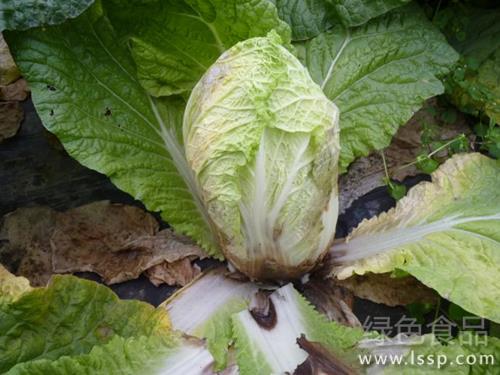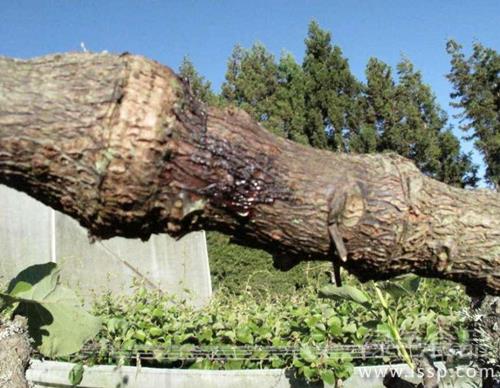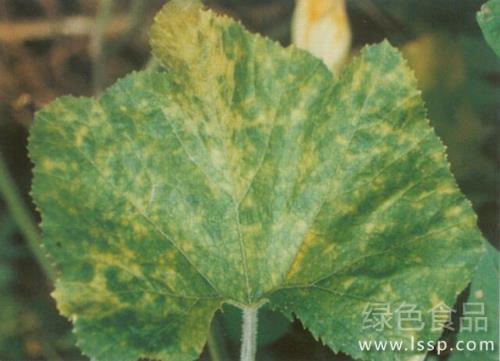Prevention and control of soft rot of inverted cabbage on the push of Chinese cabbage rhizome rot
Chinese cabbage soft rot, also known as rotten pimple, rot, decaying, etc., often occurs in the heart stage of Chinese cabbage, first there are water-stained light yellow spots on the cabbage, and then expand into tawny irregular spots. At first, the outer leaves of Chinese cabbage drooped in the hot sun, but they could recover sooner or later. With the development of the disease, the whole plant wilted, and the outer leaves were flat to the ground, revealing the leaf ball.

Soft rot of Chinese cabbage
The heart pulp tissue at the stem and root neck of susceptible cabbage is completely rotten, full of yellow sticky matter, and gives off a bad smell, which falls down as soon as you touch the cabbage plant with your feet, or picked up by the picker. Sometimes, light from the edge of the outer leaf wet rot, or from the top of the heart leaf, gradually spread to the lower part, and finally cause rotten bumps. Identification points: the outer leaves of Chinese cabbage droop or the whole plant wilts, the stems and heart leaves rot, and there is a bad smell.
Prevention and control technology: comprehensive control, that is, agricultural control, biological control, chemical pesticide control.
1. Select disease-resistant varieties and select varieties according to local conditions.
2. Rotation: avoid stubble with melons, Solanaceae, celery, lettuce, lettuce, cruciferous vegetables (such as cabbage, cauliflower, radish), and practice rotation with lily vegetables (leeks, onions, garlic, etc.) or legume crops for more than 2 years.
3. Sowing at the right time.
4. Cultivation and control: select high terrain, low groundwater level and fertile land for planting. Cultivated with high or half-high ridges. Apply sufficient base fertilizer and increase the application of phosphorus and potassium fertilizer. Timely inspection during the pericardial period, once the diseased plant is found, it should be removed and taken out of the field, buried or burned, and the hole should be disinfected with lime or 20% lime water.
5. Biological control and disinfection of soil in the sowing ditch, 1000 grams of 1% Zhongshengmycin (Nongkang 751) water agent, mix 30 kg fine soil, mix well, apply evenly on each ridge and ditch, and then water.
6. Chemical pesticide prevention and control: in the early stage of the disease, timely spraying prevention and treatment can be carried out by irrigating roots with 1000 times of Dexong wettable powder, and at the same time, spraying with 1000 times of Dysenamine water agent to achieve the combination of sprinkler and irrigation, and the effect is better. Once every 7-10 days, continuous irrigation for 2-3 times. In addition, pesticides should be used to control cabbage pests in time.
- Prev

Control measures of kiwifruit canker with long spots and withered trunk in red spots of leaves
Control measures of kiwifruit canker with long spots and withered trunk in red spots of leaves
- Next

Prevention and treatment of papaya mosaic disease with yellow and green symptoms in tender leaves
Prevention and treatment of papaya mosaic disease with yellow and green symptoms in tender leaves
Related
- Fuxing push coffee new agricultural production and marketing class: lack of small-scale processing plants
- Jujube rice field leisure farm deep ploughing Yilan for five years to create a space for organic food and play
- Nongyu Farm-A trial of organic papaya for brave women with advanced technology
- Four points for attention in the prevention and control of diseases and insect pests of edible fungi
- How to add nutrient solution to Edible Fungi
- Is there any good way to control edible fungus mites?
- Open Inoculation Technology of Edible Fungi
- Is there any clever way to use fertilizer for edible fungus in winter?
- What agents are used to kill the pathogens of edible fungi in the mushroom shed?
- Rapid drying of Edible Fungi

